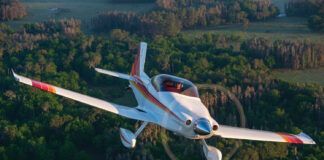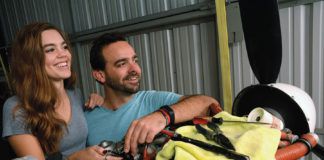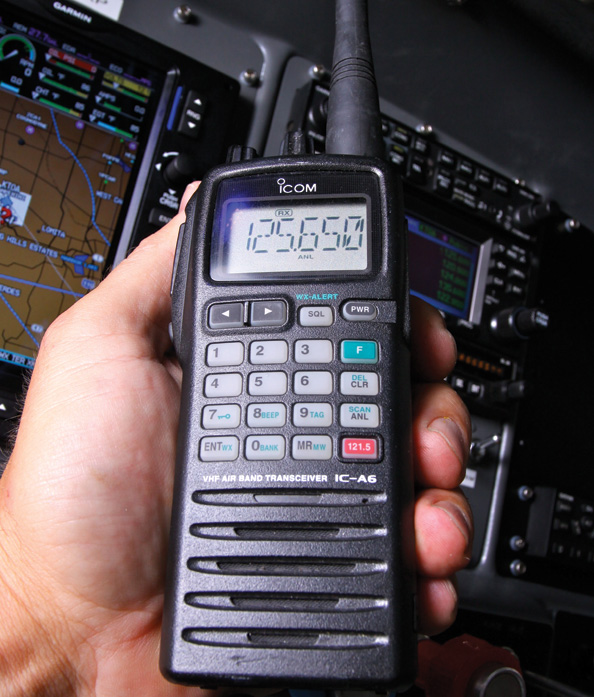
Editors Note: This excellent comparison was excerpted from the July 2010 issue of our sister publication, Aviation Consumer.
Pilots who routinely fly in instrument conditions tend to spend a lot of time thinking about failures. As in, what will happen when Equipment X doesn’t work? Can I get to my destination safely with what I have left? And what if Equipment Y also fails? So it goes until you’re left with nothing more than engine power, a book of matches and a roll of duct tape.
One arrow in the quiver of redundancy is the handheld VHF com radio. For homebuilders, the popular portable transceiver can be either a backup to a pair of com radios in the stack, a second com to pick up ATIS or listen in on Flight Watch, or for those of you flying light designs, it might be your only means of wireless communication.
The playing field for handheld VHF radios is broad, but not all units are created equal. Portables must have a high-end transmitter with a modulator that can reach reasonable distances at altitude. They must offer a headset interface. They must be small enough to stow in a map pocket but large enough for easy use in high-workload emergencies.
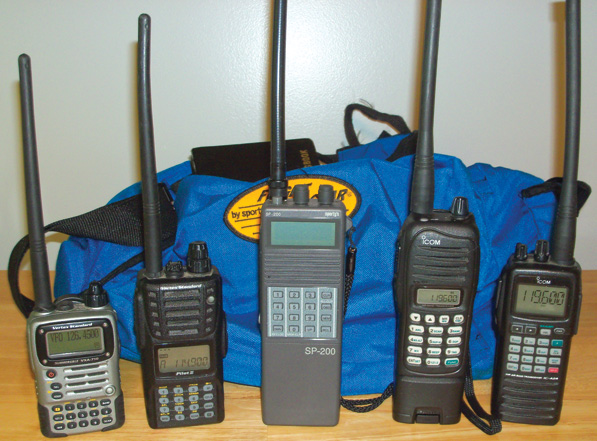
Sportys SP-200 (center) is a bit big. ICOMs (right-hand two) are a good balance of small case and sizable buttons. Sportys new SP-400 is about the size of the Vertex VXA-300 (second from left).
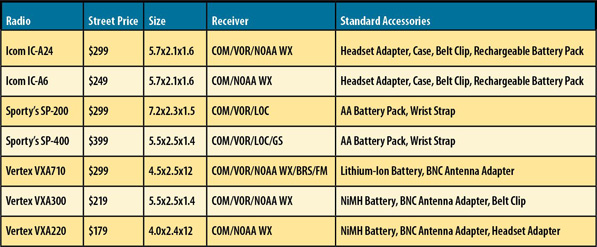
Gettin the Geek Out
Nearly all portable airborne radios offer roughly 1 watt of transmit power (which is still way more than your average cell phone). Contrast this to a panel-mount radio that transmits 10 to 15 watts of power, and you see why an external antenna is almost a required accessory.
The quality of the built-in microphone also matters. In our view, headsets are required when using any portable com in the cabin of a piston aircraft. But there could be a time when your only headset fails and your portable is your sole option.
Each transceiver was saddled to a calibrated spectrum analyzer that measured both transmit power output and receiver sensitivity. We also tested the nav receivers in the units that were so equipped with a calibrated nav-signal generator, injecting a signal directly into the units receiver and radiating a signal to the units rubber antenna.
The units were also used in flight, were stuffed into unorganized flight bags and were strutted around the airfield in cargo pants pockets. We even tested them in the kitchen over morning coffee where, despite roughly 12 miles of hilly terrain between us and the airfield, all but the Vertex units could pull in the ATIS at half-open squelch.
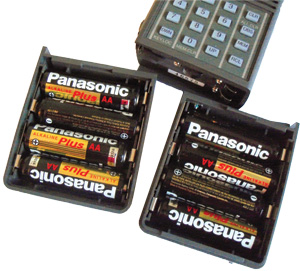
Part of the bulk found in the budget-minded SP-200 from Sportys is this eight-cell battery pack.
Sportys Old and New
The SP-200 has always represented a good value. Its a no-nonsense unit that can be applauded for its simple yet rugged design. Sportys offers the most robust units of those tested. Its also the largest in the group, measuring 7.2 inches tall, 2.3 inches wide and 1.5 inches deep. It weighs 17 ounces with the battery pack. This isn’t a problem unless you want to stuff the thing in your pocket.
The real issue with it-and with the others tested-is the number of AA batteries it requires: eight in all. There is a NiCad option, but Sportys recommends using alkaline because their storage life is more predictable when the unit is used for emergency backup. To its credit, the duty cycle when running on alkaline is quite good. If you limit your transmissions and display lighting, its stamina is over 15 hours. In three weeks of testing, we never had to change batteries.
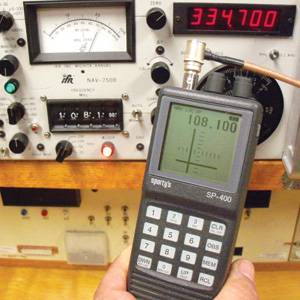
Sportys SP-400 hits the target of rugged construction and simplicity without sacrificing any essential functions. Its also the only unit with a glideslope receiver.
The controls and lockable keypad are hearty and easy to use. Simple volume and squelch knobs and a last-frequency recall button are nicely spaced apart on the top of the case, while the transmit and display and key light buttons are on the side. You can easily pick this unit up and use all of its features without touching the manual. Especially nice are the Clear key (which erases a digit if you botch a frequency entry) and the frequency memory storage.
The nav side includes a VOR and Localizer receiver that allows for OBS selection and includes electronic CDI at the top of the LCD display. The nav receiver was excellent, with solid reception in the aircraft and on the test bench using the BNC-connected rubber antenna.
The unit might have come with a headset adapter as standard, but at a price of $199 its tough to complain. Popular options include the NiCad battery, external power plug, carry case and spare AA battery cases.
Sportys offered us the first look at the new $399 SP-400. Unique to this unit is a glideslope receiver, which could save your hide if you had to slide down an ILS with a dark panel. The SP-400 performed exceptionally well, with the localizer receiving down to 115 dB and glideslope down to 95 dB going directly into the receiver, better than some panel-mounted gear. Equally impressive was the units com performance, with crisp modulation and decent receiver sensitivity. The unit has good transmit sidetone (the sound of your voice that you hear when you transmit) with headsets.

The Sportys SP-400 has several display options including a course-deviation indicator for VOR use (left), memory frequencies (center), and a true ILS presentation (right) thats unique among handheld radios.
The SP-400 is comfortable in hand and the LCD display is sharp, but its side viewing angle wasn’t impressive. This is not uncommon with monochrome LCD screens, but display backlighting can help.
Like the lesser SP-200, this unit uses AA alkaline batteries that offer plenty of juice. If this unit were to be used as a primary (and for some applications, it may be worthy of the task), we suggest connecting an external 12 volts. There’s a headset adapter standard, but the clean modulation from the internal microphone and a reasonably loud speaker were impressive.
Icom
The popular A24 is the flagship model from Icom and features com and nav functionality (the A16 is an identical unit less navigational functions). Icom brags of the units single-handed operation for use while flying, and it seems to fit the task. With battery pack, it measures 5.1 inches tall by 2.1 inches wide by 1.6 inches thick, and weighs roughly 15 ounces. This proved to be a near perfect stature for a portable. However, upon first using the unit we found some of the controls to be out of place. For instance, squelch is adjusted by pressing a dedicated Squelch key and then setting threshold with the right rotary knob. A dedicated, one-shot squelch adjustment would be on our wish list.
Throughout testing we grabbed the more prominent rotary knob at the top of the case to adjust the volume. Wrong control. This knob changes the frequency (rather than keying it in from the keypad.) Even so, this knob was too close to the flexible antenna.
The nav feature is easy to use and offers both To/From navigation and the current radial. It also shows a CDI. It wasn’t as good a performer as the Sportys in nav mode and seemed susceptible to RF interference. The NOAA weather radio alert function when plugged into a wall outlet (the weather function can also be used when on the airband) is commendable. There’s a 200-channel memory bank for frequency storage, which might be overkill. All of the Icom units have a good display with easy-to-read characters in all lighting conditions. The unit has a 1650 mAh NiMH battery with excellent endurance. A double-A pack is available.
Icoms A14 is a communications-only portable with a special 700mW loudspeaker using a BTL amplifier (essentially dual amplifiers that drive both ends of a speaker load). This makes the A14 output loud. So loud, in fact, that while taxiing a Grumman Tiger with the canopy open, we could easily communicate with ground control during a maintenance runup. [Should be just about right for your basic RV.-Ed.]
The unit tested had the optional six-battery AA alkaline pack, which gave the unit a large footprint. Standard is the lithium-ion pack advertised at 18 hours of use. We liked the simplicity of the A14 as well as its rugged case and easy to use buttons. We didn’t care for the squelch keys that are built into the side of the case, below the transmit key, that bring up a squelch value on the display. A dedicated knob would be better and more convenient.
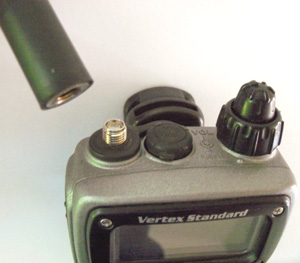
One demerit for the Vertex radios is the use of an SMA connector between the body and the antenna, requiring a similar connector for an external antenna. (Obviously.) Better is the industry-standard BNC.
Vertex Standard
The small size of the Vertex units, as well as some smart features, were impressive, but the feel and occasional quirkiness of the controls werent. The SMA antenna connections require using an included adaptor if connected to most external antenna setups. It also took awhile to figure out the screw-in style microphone and headphone jack at the top of the case.
The smart features include a keypad beep when punching in frequencies (which the Sportys does not have) and the bright, dot-matrix displays. The battery-saver function sends the units receiver into hibernation mode when its quiet.
One day we had the VXA-300 and Icom A24 side by side and found the Vertex would sometimes clip the first part of a transmission, receiving a second or so after the Icom. Presumably this was the result of the receiver coming out of hibernation. The transmitter was good with over a watt of carrier on the scope and a high-quality modulator.
The VXA-300 Pilot III is a nav/com (the VXA-220 is com only, but with a loudspeaker). Controls are not as intuitive as the Sportys or Icom models. For instance, the on/off rotary knob serves triple-duty as power, volume and menu access. You press the knob for accessing unit menus. Its not bad, just different, and some owners may stumble.
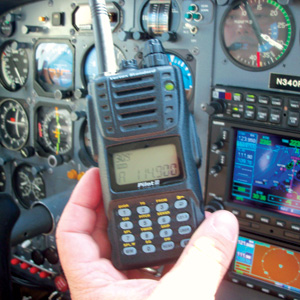
Vertex units, like this VXA-300, performed well, but have a complex operating logic that hampers their utility.
The VXA-300 performed well in the real world and the units stature proved perfect for ease of carrying and single-handed operation. The nav receiver was spot on with the onboard GNS 430W. Interesting is the variable audio tone (audio pitch, really) control that can be set for a specific condition. Panel-mounted radios could benefit from this feature. There’s also a voice-actuated function for hands-free use. For instance, when a headset is plugged in, the unit will automatically begin transmitting, similar to a VOX intercom.
The Vertex VXA-710 is a tiny submersible nav/com unit measuring only 4.5 inches by 2.5 inches by 1.2 inches, the smallest of the test group. While it may be easy to carry, its buttons were too small, and the zero key was placed in an awkward location in the keypad. But this wasn’t as awkward as the feature set.
For days we couldn’t find a squelch adjustment on the 710. A search of the manual revealed that it was buried in a menu. In fact, a couple of times we turned the unit off and then back on because we became so lost in button pushing, which suggests that this unit may be too complex for an airband backup or primary.
Keypads and LCD screens are illuminated in Vertex Standards renowned Omni-Glow amber hue, for increased visibility and minimal impact on night vision. Omni-Glow can be configured for both brightness and contrast. We cant come close to covering all of the features that the Vertex models offer, which gives you some idea of how complex they are.
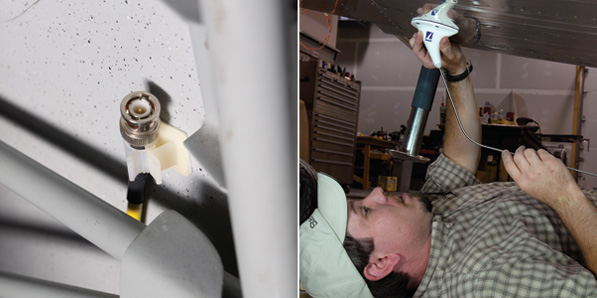
An external antenna is critical for using a handheld radio as a true backup. Here, an unused com antenna has been stubbed out to a convenient location. A short cable can be connected from here to the handheld when needed. Keep it and the headset adapter together; you’ll want both.
Summing Up
A closing comment: Gulf Coast Avionics in Lakeland, Florida, provided some of the samples for this article, while Icom and Vertex ignored [Aviation Consumers] requests for units to review, and Sportys went above and beyond. Coincidentally, the Sportys SP-400 was the top pick. Its performance is clearly exceptional and worthy for sole-means navigation, including an emergency ILS should your bad day really come to that. At a price of $395 before any discounts it is a solid bargain.
After using the SP-200 and 400, we were put off by the busy feature set of the competitors. Simple is better in an aviation portable.
For a well-rounded, reliable and feature-rich portable, consider the Icom A24, but the extra dough for the nav function is questionable. You might instead opt for the IC-A6.
Nearly everyone who flies IFR, or even VFR, has a portable GPS that will be superior to navigating by a VOR using a handheld. But in the event of an emergency, a reliable, easy-to-use backup unit could be your ace in the hole.

![]()
Larry Anglisano is the Avionics Editor of sister publication Aviation Consumer and flight test pilot/inspector for an avionics repair station in Connecticut.










